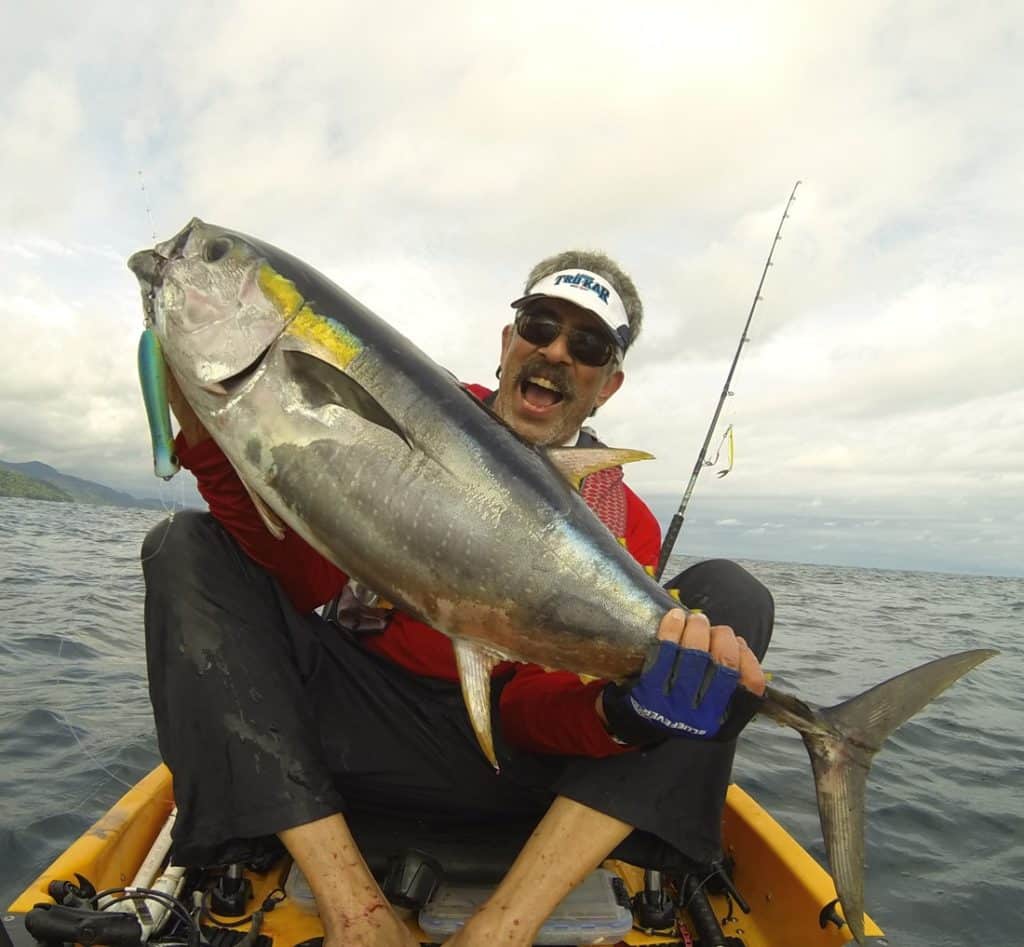The subtle rise and fall of groundswells under the piece of yellow plastic that separated my butt from the deep blue Pacific Ocean was almost soporific. I drifted close to a mile offshore of Panama’s Azuero Peninsula — a remote and rugged, jungle-covered stretch of coastline — appreciating the tranquility, as I finished tying a popper onto 80-pound fluoro leader with a loop knot.
That tranquility proved short-lived. Minutes later, one of the other five kayak anglers around me, each bobbing about on a brightly colored Hobie Outback in the muted late-afternoon light, shattered the peace.
“Fish on! Tuna!” one screamed.
I took in the hard bend of his live-bait rod as well as several yellowfin crashing the surface just beyond. As I pedaled toward the action like a maniac, I flipped the bail on an Okuma Raw II 80 spinner, filled with 80-pound braid, ready to cast.
Other _kayakeros _were hooking up. I made it a point to stay well clear of Kevin Nakada, fishing-team coordinator with Hobie, fighting a yellowfin on the popper he’d cast off his bow, while leaving his live blue runner trailing behind: He now had two crazily bent rods, each pointing off opposite ends his kayak!
Chaos Amid Busting Tuna
As I neared the area where I’d seen the commotion, nothing broke the surface. Had I missed a fast-moving school? I recalled that Pascal Artieda, who operated his “wild coast” kayak-fishing camp, had advised us to make casts with poppers even when tuna weren’t busting.
I did, and halfway back to the kayak, a tuna burst from the surface 20 feet behind the Yo-Zuri Sashimi Bull. I gazed in awe as it chased down the lure and clobbered it.
A yee-haw! battle ensued that had the kayak variously sleigh-riding ahead and spinning, toplike, as I pedaled around the circling tuna in an effort to keep the rod pointing off a bow quadrant and never behind me.
Ultimately, I released a 40-pounder or so (that release made easier and safer since I’d replaced the treble hooks on most lures with strong singles).
Then I pedaled quickly over to Chris Russell of Denver, with my GoPro in hand and ready to shoot the 60-pounder he was easing into his kayak to disengage a popper.
In fact, all anglers were busy hooking, fighting or releasing yellowfin — the best sort of chaos.
Bad Place to Be a Live Bait
That tuna bite capped off quite a day. Early on, we’d pedaled out of the small, protected cove where Artieda and his associate, fellow Frenchman Aurelian Perez, have set up their remote camp. A small river flows into one corner of the picturesque cove.
One rule of thumb we found in the two-and-a-half days we fished here: A live bait isn’t safe anywhere at any time except in a livewell.
With that in mind, shortly after sunup, I had dropped a live runner over the side barely outside the bay, planning to slow-troll it out to deeper reefs. But I didn’t get more than 200 feet or so before something slammed it, and right there in front of the camp, I had one hell of a fight on my hands. My adversary turned out to be a large roosterfish.
That day and the next, we caught more roosters, cubera snapper to 60 pounds, Colorado snapper, barred pargo, amberjack, African pompano, Pacific crevalle, bluefin trevally, Sierra and more. We caught fish while trolling live bait and lures, and while drifting — dropping jigs or tossing poppers. We caught ’em a mile offshore (where the water is very blue and very deep), over reefs closer to shore, and right along the surf-washed rocky headlands of the wild coast.
Wilderness Camp in Style
As the sun fell, everyone pedaled back to camp and carried kayaks well up on the beach for the night. In the clearing marking the outpost camp, showers were available, though I chose the cool, clear fresh water flowing out of the river for a welcome cleanup.
After sashimi appetizer and a great dinner (with the day’s catch as the main dish), we sat and sipped our wine (hey, these guys are French; I liked their version of roughing it), and relived the day’s many exciting moments. Even a half-hour torrential downpour couldn’t dampen our heady spirits.
Before long, most were ready to get some shut-eye; each angler crawled into his own tent, where an air mattress, sheets and a towel waited. They were good tents, and the rain fly had kept mine dry inside. I slept amazingly well both nights we were there.
Yes, we had to contend with a few mosquitoes. And at times, we had to hunker down under a tarp to stay dry. But all participants agreed that they wouldn’t have traded the experience for a plush resort.
Over Land and Water to the Wild Coast
About eight years ago, Artieda opened his Panafishing Adventure Lodge near Pedasi. From 26-foot cats and 25-foot super pangas, anglers caught all the species mentioned above plus good numbers of sailfish, at times mahi and more.
Then Artieda tried kayak fishing and was hooked — so much so that he bought a fleet of Hobies (five Outbacks and two Pro Anglers) and started offering kayak fishing around Pedasi (where it usually remains calm when the ocean gets breezy) for roosterfish, in particular. (Artieda had fished Hobies and said he recognized the almost-effortless and hands-free pedal system as the only way to go for serious fishing.)
Soon he was taking anglers to multiday adventures based out of his secret cove on the wild coast.
To get there requires about a five-hour drive (some of that smooth and easy, some w-w-w-washboard) from Pedasi to Cambutal, where the road ends at a large bay rimmed with an immense sand beach, on the southernmost Azuero Peninsula. From there, anglers transfer with their gear to pangas for another hour-and-a-half scenic cruise west along this “tuna coast” — as remote as any you’ll find in Panama — to the outpost camp. As to why it’s called the tuna coast, and why it’s so productive, search Google Earth for “Azuero Peninsula” and note the precipitous drop to abyssal depths almost at the shoreline!
Waiting at the camp: a central cooking/lounging tent, a large patio tent with mosquito netting for dining and tents. (At press time, a new and improved base camp is under construction, which will feature huts on wooden platforms with showers, a bar, tables and other amenities.)
And of course, there were the kayaks, ready for us to hop onto and go. Sometimes Artieda and Perez will load kayaks onto skiffs to travel up or down the coast to specific reefs or areas where they’ll find feeding tuna and other pelagics, but the grounds just in front of the camp are hard to beat, and one need only jump into a kayak and pedal a few minutes to start fishing.
Return Trip
We ended up spending only a couple of full days off the Azuero Peninsula, with Artieda deciding we should head back just before the groundswell was predicted to grow considerably. (Though running through some squall lines still made for an exhilarating ride back to Cambutal.)
That was in late May, when things can (as they did) get wet at times, though Artieda cites spring as a good time for big yellowfin. Most of the season, winds and seas are light here, but if a wind does blow in spring or summer, it will be from a southerly quadrant and can rough things up. In that case, it’s a fine time to fish for big roosters in the calm waters around Pedasi.
On the other hand, in winter, if a wind comes up, it generally blows from the north, Artieda says. That means the high cliffs of the wild coast offer great protection, so most of the time, kayakeros pedal out onto a flat sea.
And as long as the weather remains cooperative, Artieda will schedule wild coast adventures for five days and nights — or longer or shorter per a group’s wishes.
For anyone who appreciates the unique pleasures of fishing from a kayak, I’d have to call this ultimate adventure a must, based on our trip this past spring. In fact, I already scheduled a return trip for this winter.
Planning a Kayak-Fishing Trip to Panama’s Wild Coast
Who: Experienced kayak anglers. These are big fish, and this is not a place for novices to try their hand. (Experience notwithstanding, Artieda keeps one skiff, with VHF, out on the grounds for every two or three kayaks, for both support and safety reasons. Also, skiffs may be used to run kayaks and anglers to spots farther up the coast.)
When: December through May (seasonality discussed in text of feature)
Travel: A number of major airlines fly into Panama City. Copa offers direct flights from several U.S. cities, and I’ve generally flown Copa. (However, while I’ve had no problems thus far, I must point out that the airline’s contradictory baggage rules for fishing gear allow a “container” up to 115 total linear inches but then specify that no gear may exceed 80 inches; my efforts for some clarification have gone unanswered. For those who travel with 7-foot rods, note that United, American and Delta — all of which fly into Panama City — allow for up to 115 linear inches.)
Once your group arrives at Tocumen International Airport, you can overnight in Panama City, or you can arrange to leave for the wild coast right away (especially if you can arrive before midday). Artieda will have a van waiting — and a truck as well, if all anglers have a load of gear, as we did. It’s a bit more than five hours (with a lunch stop), a ride I didn’t mind since it meant we didn’t face the severe gear restrictions that flying in via a small, regional, in-country airline would have meant.
Depending on timing and logistics you’ll arrange with Artieda, you might overnight at the lodge or head right out to the wild coast.
What to bring: Your favorite rods/reels. The resort has limited gear. A range of 30- to 80-pound braid should serve you well. We used conventionals (Okuma’s Andros for jigging and Makaira for slow-trolling live bait), and big spinners for throwing poppers. Pack a selection of poppers, deep-diving and shallow minnow lures, and metal jigs, as well as various hooks (see “Hook Swap”) including large live-bait circle hooks (we had good results with Eagle Claw Lazer Sharps) and fluoro leader. Definitely bring a camera. Something compact and waterproof, such as a GoPro, will serve you best for shooting from a kayak. I’d also recommend good, open-fingered fishing gloves and pliers you can attach to yourself or to your kayak with a lanyard. A heavy-duty lip-gripper is a must; for some fish, a lip gaff might be useful. I consider a small waterproof VHF essential. A PLB (personal locator beacon) such as ACR’s compact Res-Q-Link is worth packing with your tackle. For camp, a flashlight comes in quite handy (or a headlamp even handier). Of course a couple of dry bags are essential.
Cost: For three or more anglers, $1,600 each covers five nights and five days of fishing on the wild coast. Add just $220 per person, and you’ll have van service from and to the airport. You may also opt for one or more overnights at the Panafishing Lodge in Pedasi, either en route to the wild coast or just to fish that (very different) area/fishery, for $100 per night.
For more information, visit panamakayakadventure.com and panafishing.com.
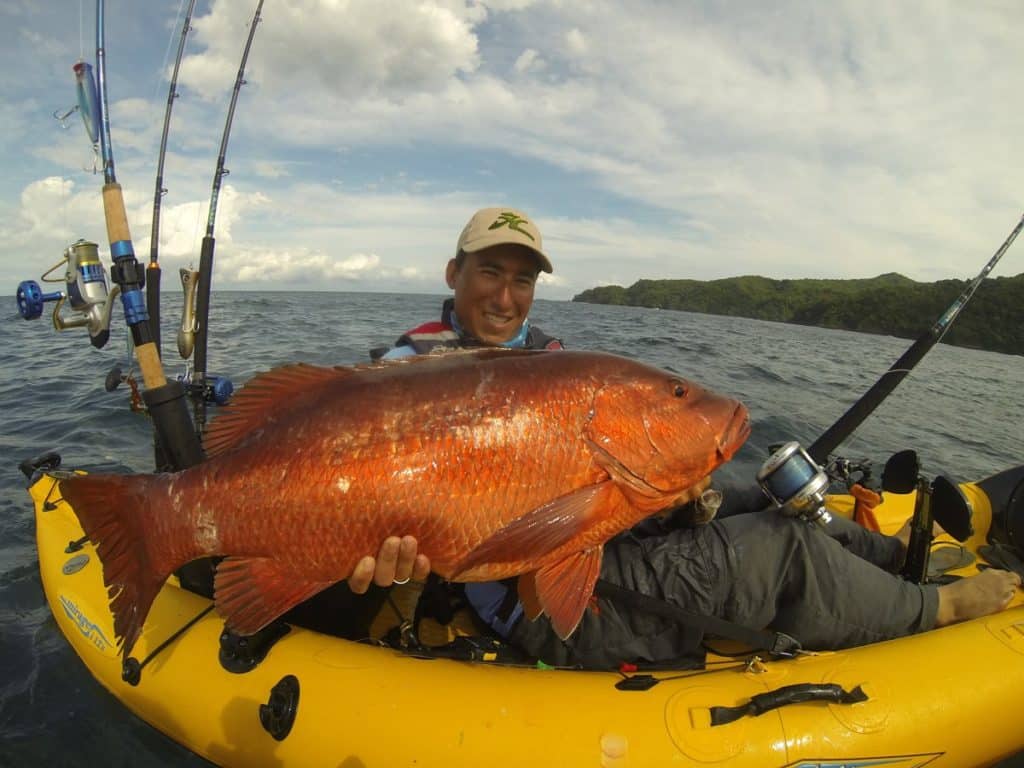
Trophy Colorado Snapper
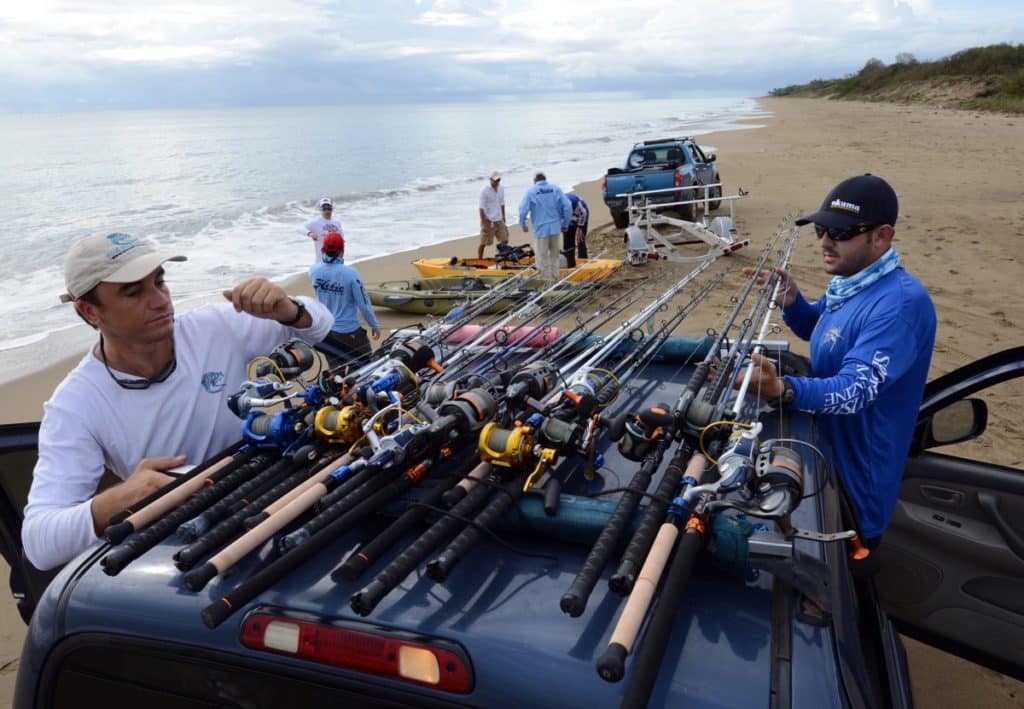
Kayakeros’ Arsenal
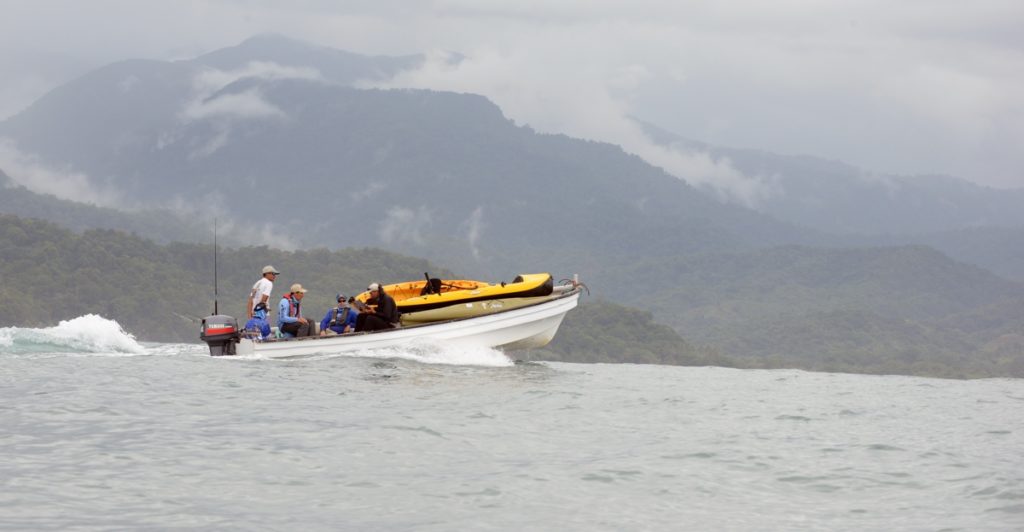
The Journey West
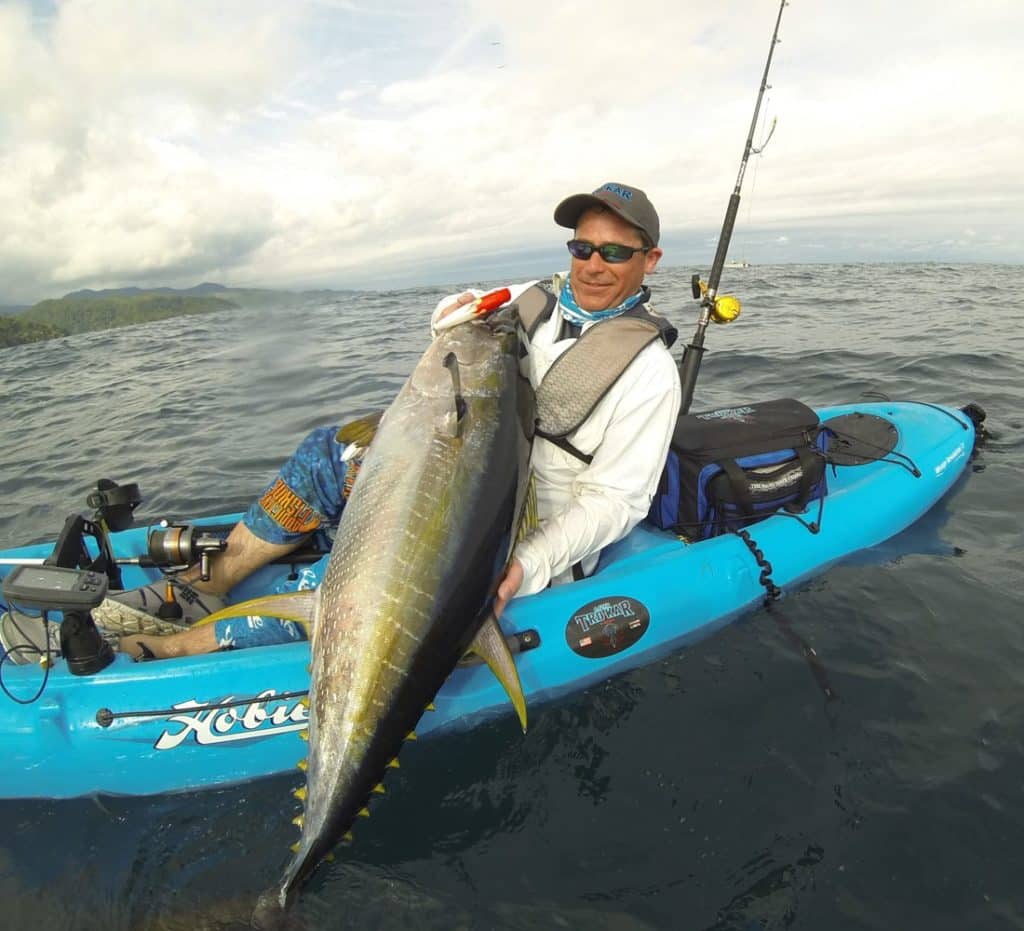
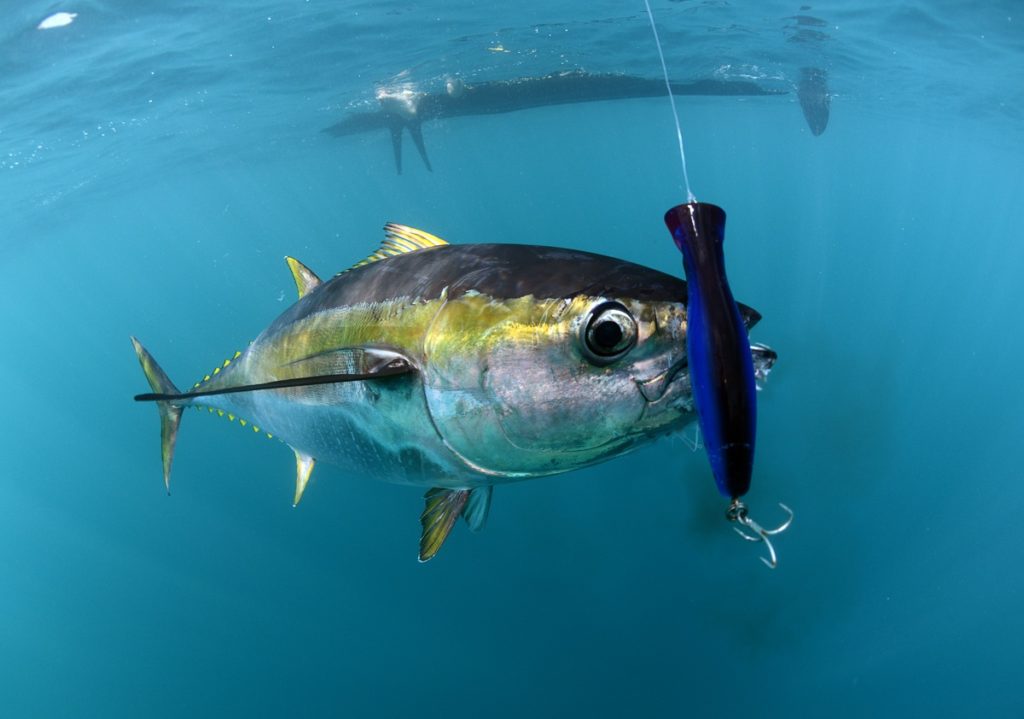
Tuna Below the Kayak
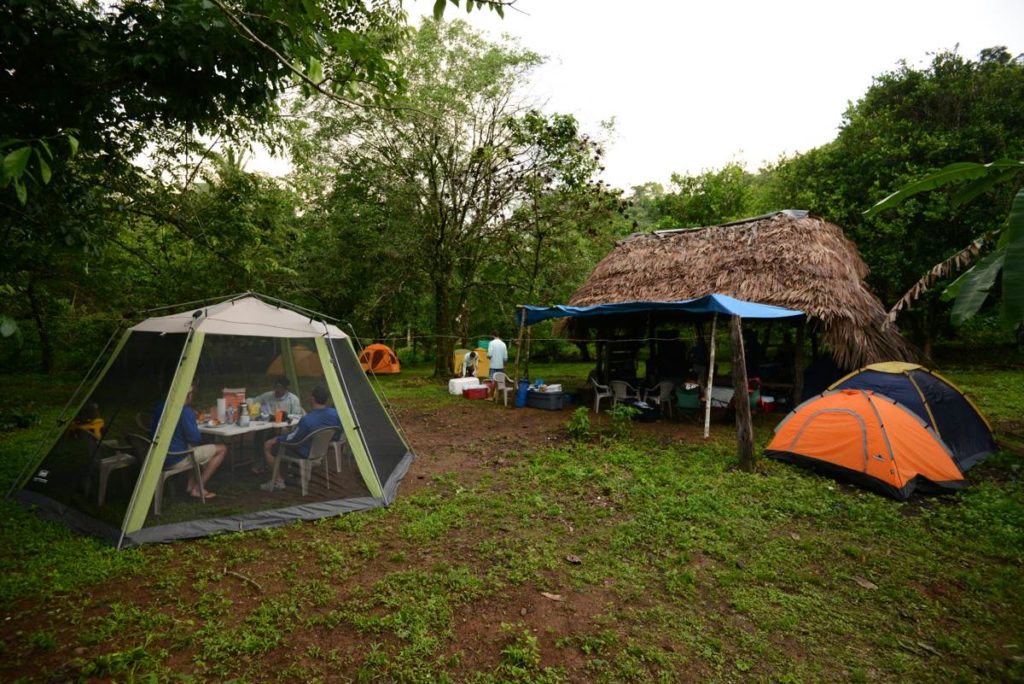
The Outpost Camp
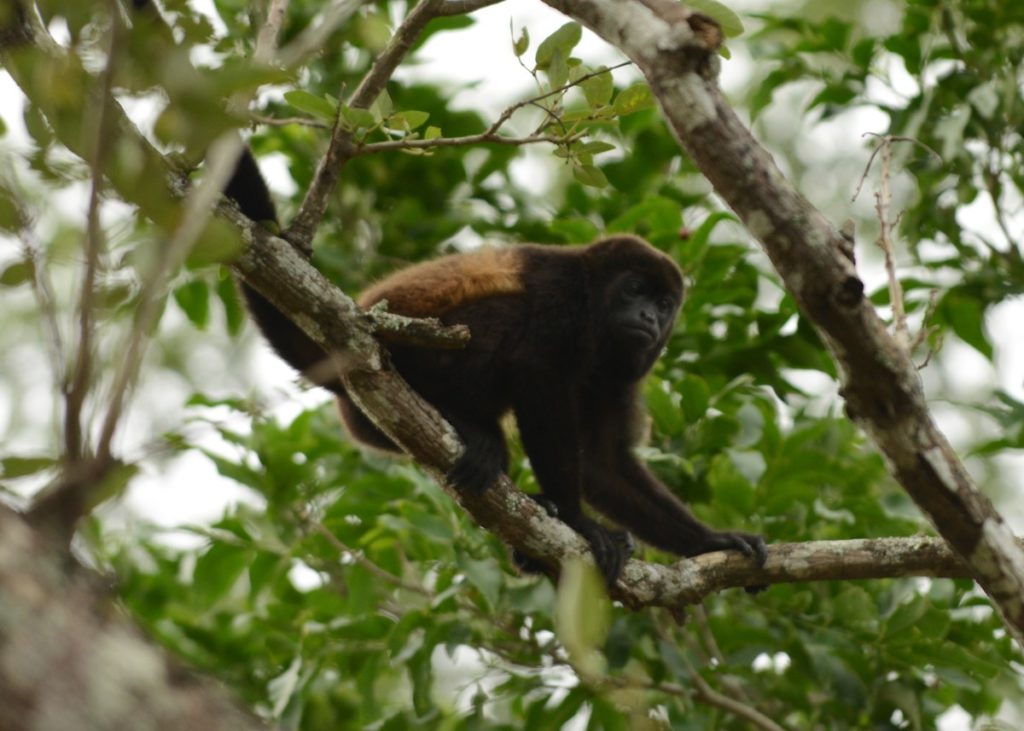
Old Man of the Trees
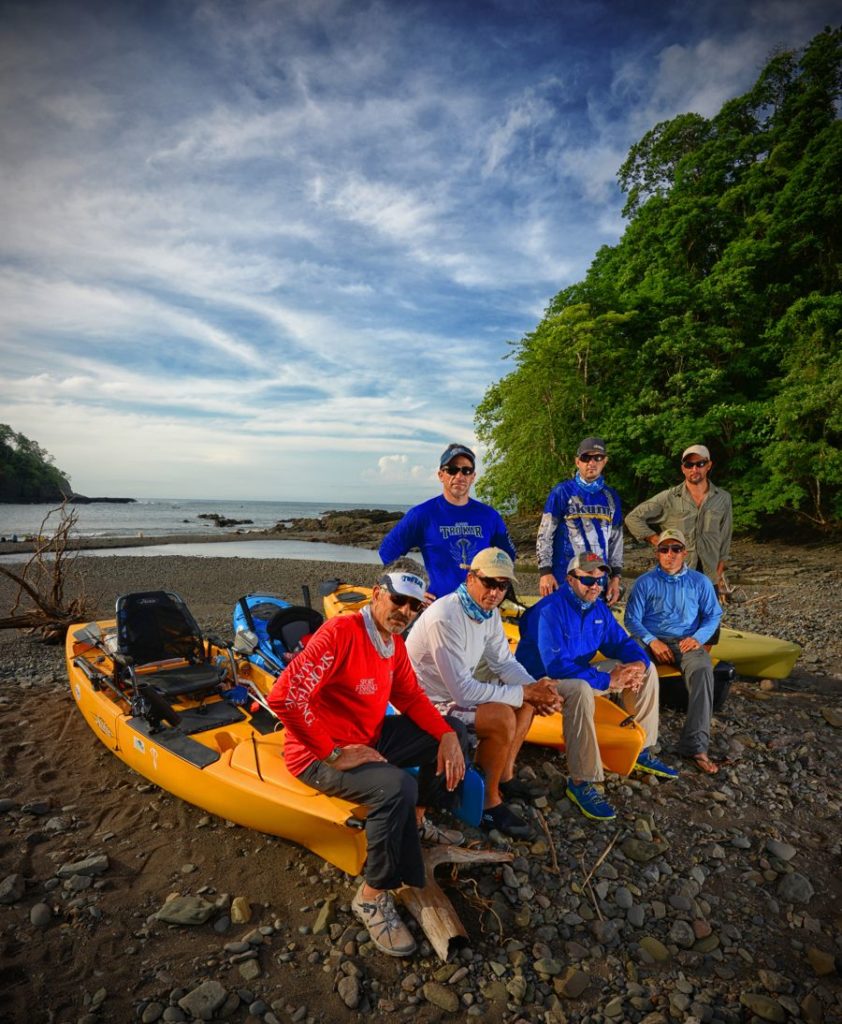
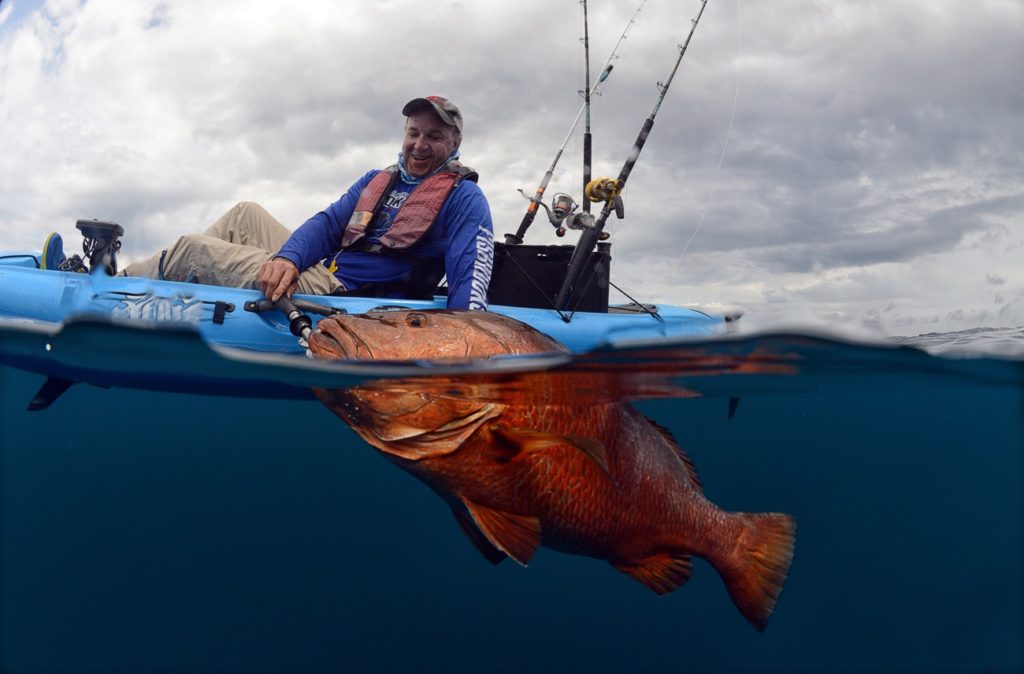
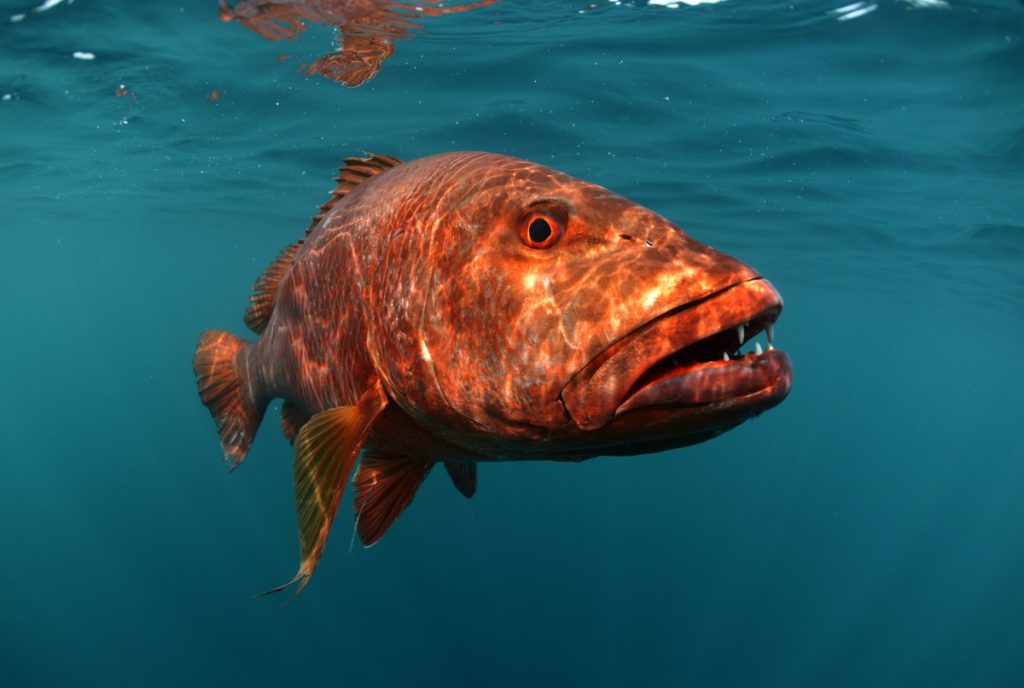
The Junkyard Dog of Eastern Pacific Reefs
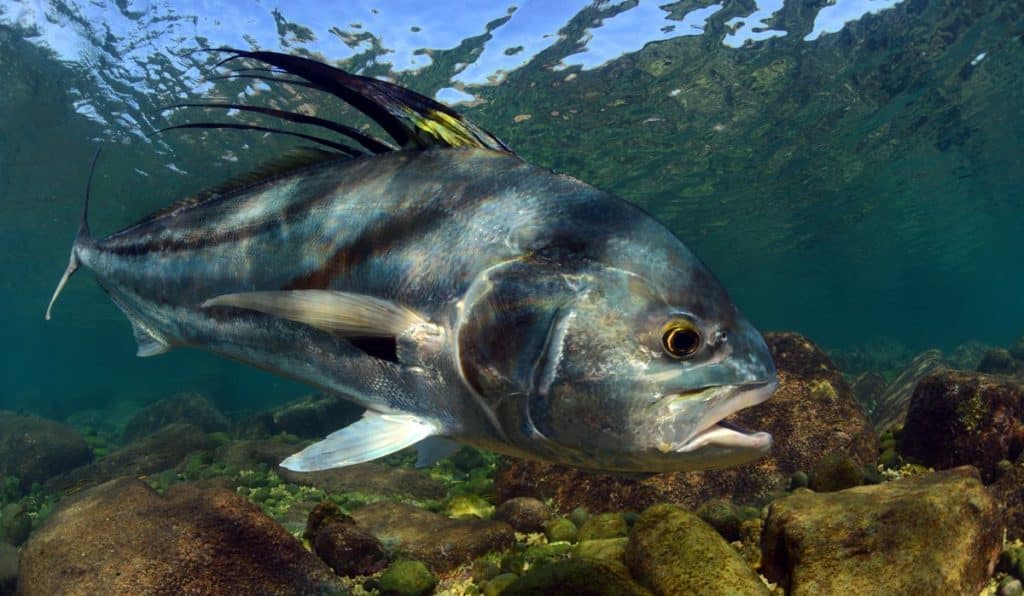
An Abundance of Roosters
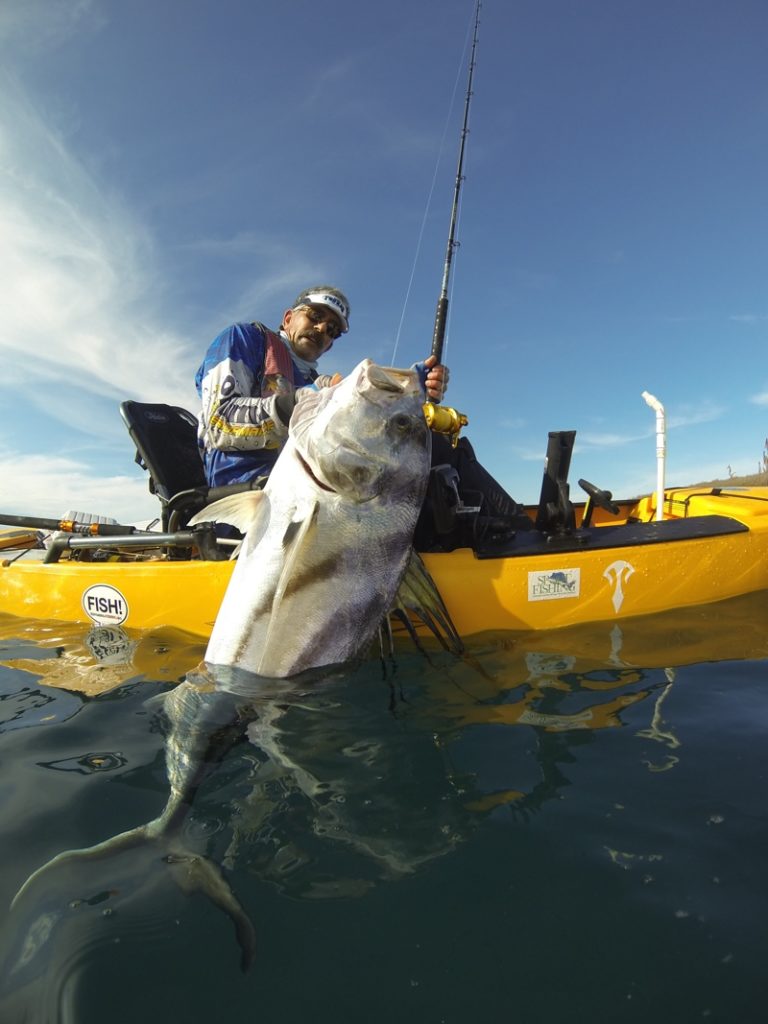
Mighty Big Rooster
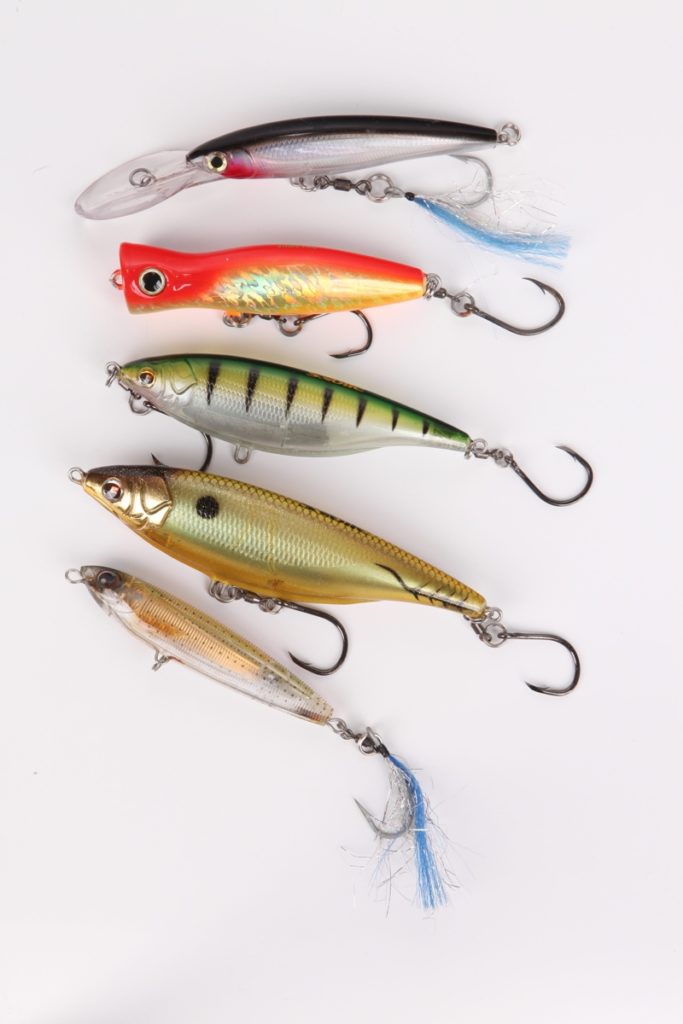
Hook Swap
